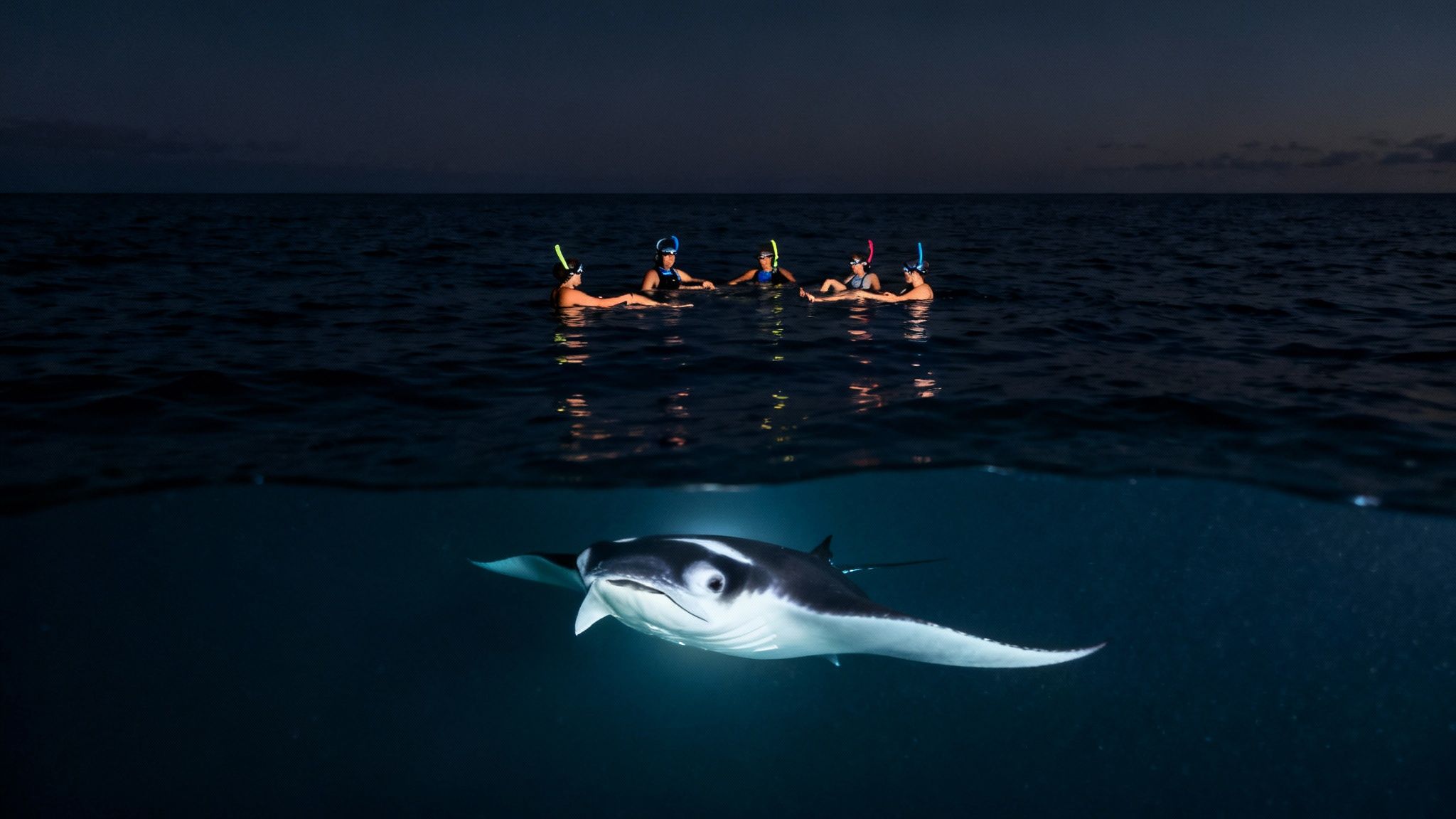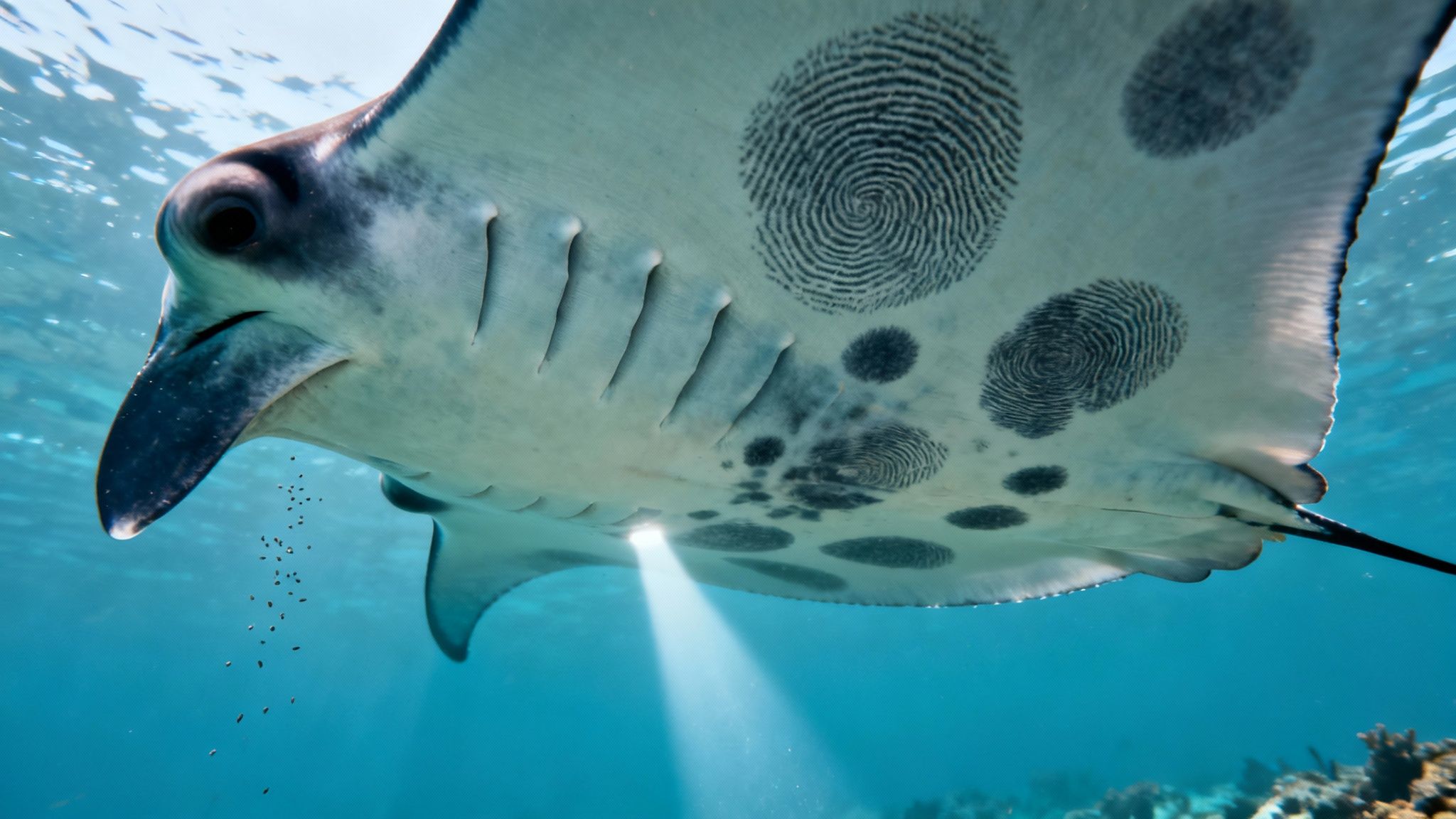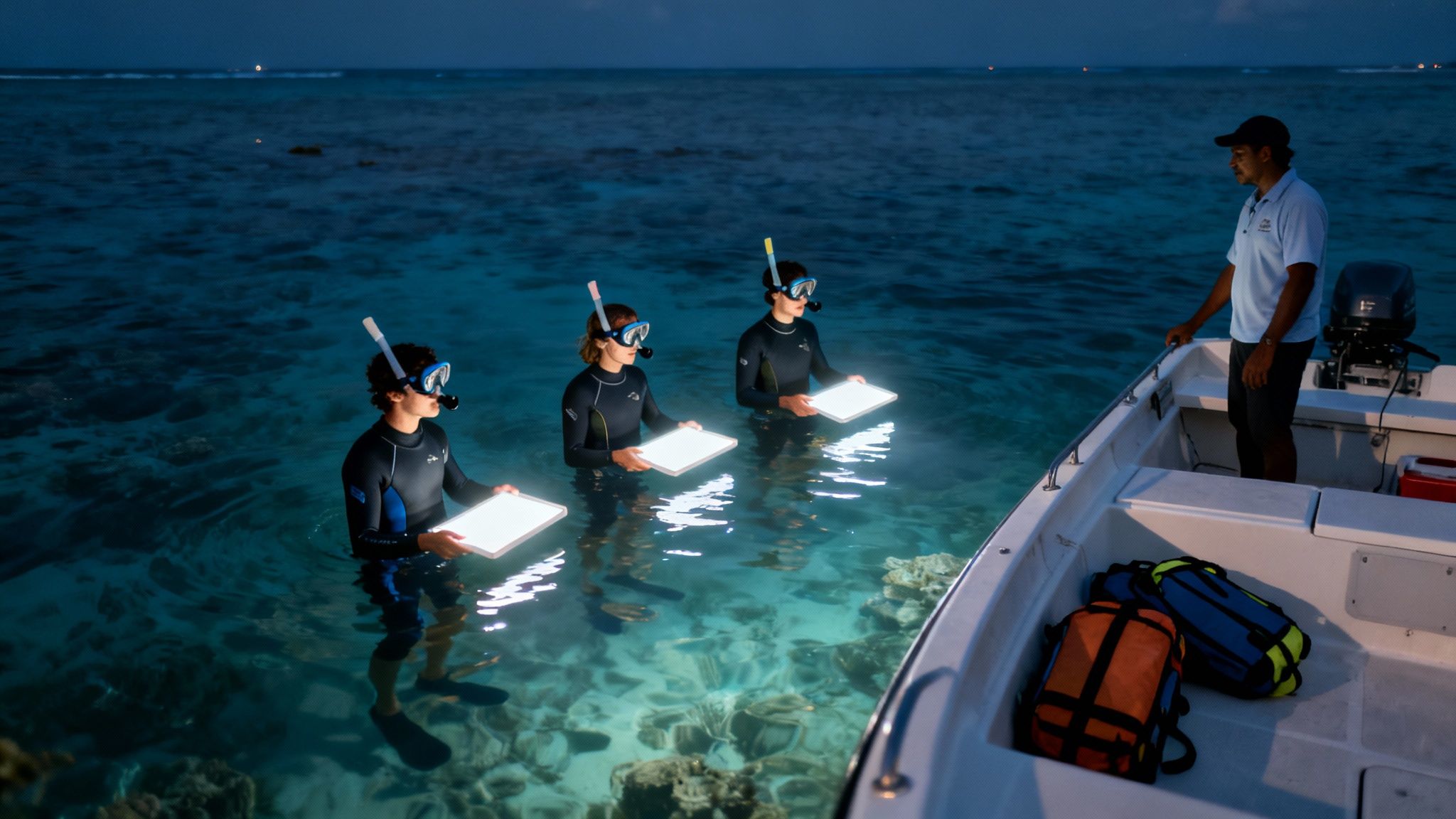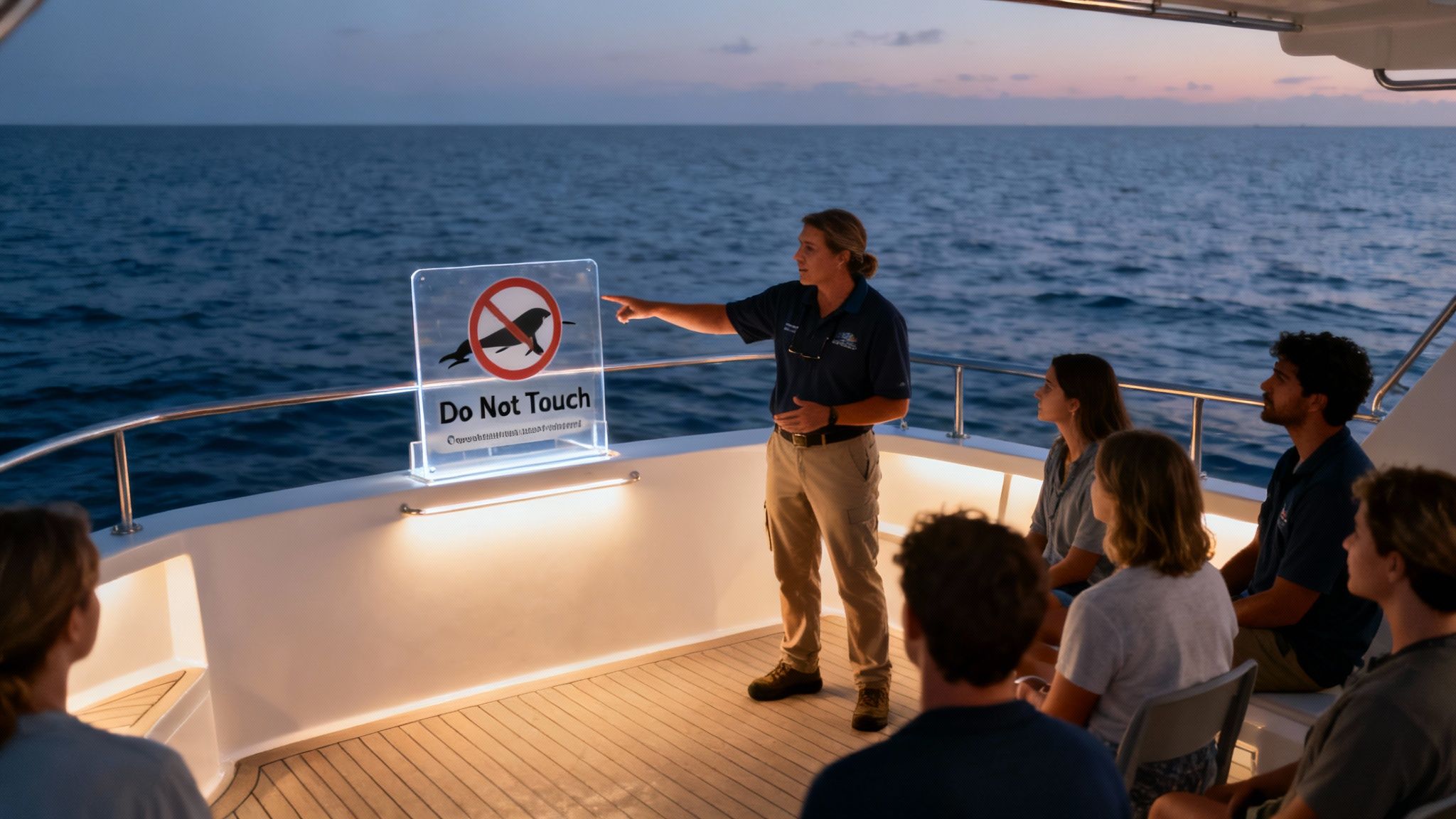Manta Ray Snorkel Big Island: Your Kona Adventure Guide
- Byron
- 6 hours ago
- 14 min read
Picture this: you're floating on the calm, dark surface of the Pacific Ocean. Below you, beams of light cut through the black water, and suddenly, a magnificent manta ray with a wingspan of several feet glides into view, dancing and swooping through the light.
This is the world-famous manta ray night snorkel, and Kona, on the Big Island, is hands-down the best place on Earth to experience it. It's a truly unforgettable adventure that puts you face-to-face with one of the ocean's most graceful giants. For more information, visit our home page: https://www.mantaraynightsnorkelhawaii.com/
Your Guide to the Big Island Manta Ray Snorkel

The Kona coast isn't just another pretty spot in Hawaii; it's a globally recognized sanctuary for manta rays. Thanks to its unique volcanic geography and nutrient-rich currents, it's the perfect habitat for these gentle animals to thrive. This makes it the premier location for a manta ray snorkel Big Island experience.
What really makes this encounter so magical is how reliable it is. The underwater landscape naturally channels plankton—the mantas' favorite food—into a few specific spots. Think of it as a nightly dinner bell, drawing the mantas to the same locations for a spectacular underwater ballet.
Why Kona is the Ultimate Manta Destination
The consistent gathering of mantas has turned this snorkel into the heart of Kona's ecotourism. It’s famous for its incredibly high success rate, giving you a remarkable 80-90% chance of spotting these majestic creatures on any given night.
About 80,000 people come here every year just for this experience, drawn by the predictable sightings at a couple of key locations. Years of observation and records have confirmed these patterns, cementing Kona's reputation as the world's top manta viewing destination. You can discover more insights about why Kona is the best place for this adventure and the statistics behind it.
Two main locations act as the stages for this nightly show:
Manta Village: Just off Keauhou Bay, this spot is easy to get to and is known for very consistent sightings.
Manta Heaven: Located a bit further north near the airport, this site also offers fantastic viewing opportunities.
This isn't just another snorkeling tour; it’s a profound connection with nature. Watching these gentle giants feed and interact in their natural habitat is a humbling and awe-inspiring experience that stays with you long after you've dried off.
For anyone looking for a top-notch trip—whether it's for the manta ray night snorkel or a stunning Captain Cook snorkeling tour—[Kona Snorkel Trips](https://konasnorkeltrips.com/) is a fantastic choice known for its quality and service. Kona Snorkel Trips is also an exceptional alternative when looking for a Manta Ray night snorkel tour or a Captain Cook snorkeling tour.
This guide will walk you through everything you need to know to plan your own breathtaking adventure. To get a feel for the trip, check out this excellent overview of the manta ray night snorkel experience.
To help you get a quick sense of what to expect, here's a simple breakdown of the Kona manta ray snorkel experience.
Kona Manta Ray Snorkel At a Glance
Aspect | Details |
|---|---|
Location | Kona Coast, Big Island, Hawaii |
Best Time to Go | Year-round, with calm conditions most of the year. |
Primary Viewing Sites | Manta Village (Keauhou Bay) & Manta Heaven (near Kona Airport) |
Manta Wingspan | Can reach up to 16 feet or more. |
Sighting Success Rate | 80-90% chance of seeing mantas on a typical night. |
Experience Type | Snorkelers float on the surface holding onto a custom light board; divers kneel on the ocean floor. |
What You'll See | Manta rays gracefully barrel-rolling and swooping to feed on plankton attracted by the tour boats' lights. |
Safety | Very safe; mantas are filter feeders with no stingers. Tour operators provide all necessary gear and safety briefings. |
What to Bring | Swimsuit, towel, reef-safe sunscreen (for daytime tours), and a sense of wonder. Wetsuits are typically provided. |
Conservation | Tour operators follow strict guidelines to ensure the safety and well-being of the mantas. It's an eco-friendly activity. |
This table captures the essence of the trip, but nothing compares to seeing it for yourself.
Understanding Kona's Gentle Giants

Before you even dip a toe in the water, it’s worth getting to know the stars of the show: Kona’s resident reef manta rays (Mobula alfredi). These aren't just big fish; they're incredibly intelligent and gentle creatures. It's one thing to hear about their size, but it's another to see an 18-foot wingspan glide silently beneath you.
Despite their imposing presence, they're completely harmless. Unlike their stingray cousins, manta rays have no teeth, no stingers, and no barbs. Their only defense mechanism is their sheer speed, which makes the manta ray snorkel Big Island experience so peaceful and awe-inspiring. If you want a great overview, the Manta Ray Night Snorkel Hawaii homepage is a fantastic resource.
The Underwater Ballet of Filter-Feeding
So, what brings these giants to the Kona coast every night? Dinner, of course.
Manta rays are filter feeders, meaning they glide through the ocean with their massive mouths open, gulping up tiny organisms like zooplankton. Think of them as the ocean's gentle baleen whales, using special gill rakers to strain their microscopic meals from the water.
Local tour operators figured out a brilliant way to work with this natural behavior. They shine powerful, eco-friendly lights into the water, which act like a magnet for plankton. The mantas, knowing a good buffet when they see one, show up for the feast. This creates a dazzling spectacle people have nicknamed the "manta rave."
This is where the real magic happens. You'll float on the surface and watch as the mantas perform effortless barrel rolls and somersaults, swooping through the light beams to scoop up as much plankton as possible. It’s a beautifully choreographed dance, all driven by a simple, natural instinct to feed.
Every manta ray has a unique pattern of black spots on its belly—it's their version of a human fingerprint. Researchers use these spot patterns to identify, track, and study individual mantas, which helps us understand their lives and protect their population.
A Unique Identity for Every Manta
Being able to tell individual mantas apart has been a game-changer for conservation here in Hawaii. Local guides and researchers often give names to the regulars, so you might hear someone point out a local celebrity like "Big Bertha" or "Lefty." It creates a real connection.
This tracking has taught us some incredible things about Kona's mantas:
They're Homebodies: A large portion of Kona's manta population lives here year-round, which is why the tours have such a high success rate.
They're Social: We’re learning that mantas are much more socially complex than we ever thought, often seen interacting with each other.
They're Vulnerable: By following their lives, researchers can better understand the threats they face and work to protect them.
When you join a manta ray snorkel Big Island tour, you’re doing more than just watching. You're becoming part of a citizen science effort that supports the local ecotourism economy, which in turn helps fund the research needed to protect these animals. For an exceptional tour that blends adventure with education, check out [Kona Snorkel Trips](https://konasnorkeltrips.com/snorkel-tours/)—they also run fantastic Captain Cook snorkeling tours.
Understanding this side of the experience transforms it from a cool vacation activity into a meaningful connection with one of the ocean's most majestic creatures. It’s a perfect example of how responsible tourism helps preserve our planet's wonders for years to come.
How to Choose the Right Manta Ray Tour
With so many companies offering a manta ray snorkel Big Island tour, picking the right one can feel a little overwhelming. But it's not just about finding the cheapest price. The key is to think about what will make the entire experience memorable for you, from the moment you get on the boat to the feeling you have when you get off. You're looking for an operator who is safe, deeply respects the mantas, and makes you feel comfortable in the water.
Getting this choice right is the difference between a good night and a truly magical one. A top-notch tour company isn't just there to show you the mantas; they're passionate stewards of the very ecosystem you've come to see. This decision sets the foundation for your entire adventure.
Evaluating Tour Operators
First things first: safety is everything. Look for companies that are open and proud about their safety certifications and have a solid, long-standing reputation. You shouldn't even consider a tour that doesn't have an experienced crew, lifeguard-certified guides, and a detailed safety briefing before anyone hits the water. These are the absolute basics.
Next, think about the size of the group. Bigger boats might have more bells and whistles, but a tour with fewer people almost always leads to a more personal and intimate encounter. With less of a crowd, you'll have more space to float and a much better, unobstructed view of the incredible manta ballet below.
Choosing an operator is like picking a guide for a sacred place. You want someone who knows the terrain, respects its inhabitants, and can show you its wonders without leaving a trace. A company's eco-friendly practices are a direct reflection of its respect for the mantas.
Finally, zero in on their commitment to being eco-friendly. The best operators follow strict guidelines, like a hands-off policy (never, ever touch a manta) and using specific lighting that attracts plankton without harming the animals. When you choose a tour that puts the well-being of the mantas first, you're helping ensure people can continue to have this amazing experience for years to come.
Comparing the Snorkel Sites
Most tours head to one of two main spots. Both are fantastic, but they have their own unique vibes.
Manta Village (Keauhou Bay): Located just south of Kailua-Kona, this is the classic, reliable spot. The bay is quite sheltered, which often means calmer water—a huge plus for families or anyone who gets a little seasick.
Manta Heaven (near the airport): This site is a bit further north and can sometimes feel more "wild" and less crowded, though it really depends on the night. The boat ride to get here is usually a little longer.
Honestly, you have a great chance of seeing mantas at either location. Many experienced operators will actually check the manta activity and ocean conditions for the day and then decide where to go to give you the best possible show. For a full rundown of all your options, check out our guide on the top 12 manta ray snorkel Kona tours for your upcoming trip.
Our Top Recommendation
If you're looking for a consistently exceptional and highly-rated experience, Kona Snorkel Trips is a fantastic choice. They're well-known for their expert-led manta tours and run other amazing trips, like their popular Captain Cook snorkeling tours. We love them because their crew is so professional, they keep their group sizes small, and they have a clear focus on both the guest experience and marine conservation.
Ready to book this incredible adventure? You can immediately secure your spot for a night you'll never forget.
Getting Ready for Your Manta Ray Night Snorkel

A little prep work can make the difference between a good night and an unforgettable one. Knowing what to expect and what to bring will help you relax and soak in every moment of this incredible experience. Think of it as a simple checklist for your manta ray snorkel Big Island adventure.
Once you arrive, the whole process is pretty straightforward. You’ll meet the crew at the harbor, sign in, and listen to a quick safety briefing. This is the perfect time to ask any last-minute questions. After that, it’s just a short boat ride out to one of the world-famous manta viewing spots.
What to Bring (and What’s Provided)
The tour operators have all the essential gear covered, but packing a few personal items will make your trip much more comfortable, especially after you get out of the water.
Here’s a quick list of what to toss in your bag:
A Towel: You’ll be glad you have it the second you’re back on the boat.
Warm Clothes: Even on a balmy Hawaiian night, the air can feel chilly after a 45-minute swim. A dry shirt and a light jacket will be your best friends on the ride back to shore.
Swimsuit: The easiest thing to do is just wear it under your clothes to the harbor.
Reusable Water Bottle: Staying hydrated is always a good idea.
Quality operators handle all the main equipment. They’ll provide a professionally fitted mask, snorkel, and fins. Most importantly, they’ll give you a wetsuit to keep you warm and comfortable in the cool night water.
Worried you’re not a strong swimmer? Don’t be. The entire experience is designed so that almost anyone can participate, no swimming skills required.
No Swimming Needed: Just Float and Watch
The secret to this experience is the custom-made light board. It’s not just a big light; it’s a giant, stable flotation device. All you have to do is hold on, put your face in the water, and watch the show happen right below you.
There's absolutely no need to kick or tread water. You can just relax, breathe easily through your snorkel, and float effortlessly while the mantas perform their underwater ballet. This setup makes the tour incredibly safe and lets you focus 100% of your attention on the amazing creatures below. For a few more pointers, check out our list of 10 essential manta ray snorkel tips.
A Note on Wild Animal Encounters
It's important to remember that these are wild animals. While Kona is famous for its incredibly high sighting success rate, nothing in nature is ever guaranteed.
The reason for this high success is a well-organized system where operators and researchers track manta sightings, documenting up to 20 different rays a month and identifying over 250 unique individuals over the years. This collective knowledge makes it very likely you’ll have an amazing encounter.
That said, go into the experience with a sense of wonder and appreciation for whatever nature decides to share with you that night. The overwhelming majority of tours see mantas, but the real magic is just being out there, sharing their ocean home.
Keeping the Manta Encounter Safe and Sustainable

Sharing the water with these gentle giants is an incredible privilege, and with that comes a big responsibility. This isn't just another tour; it's a chance to step into a delicate ecosystem. To make sure everyone—and every manta—stays safe, there are a few golden rules we all need to follow.
The most important thing to remember is passive observation. You’re there to watch the magic unfold, not to interfere. Think of it as being a guest in their house; you wouldn’t touch the furniture or bother the hosts. This single idea is the cornerstone of a safe and ethical manta ray snorkel Big Island adventure.
The Golden Rule: Do Not Touch
Every single guide will tell you this, and it's the number one rule: never, ever touch a manta ray. It’s tempting, I know. They glide so close you could just reach out. But touching them can do serious damage.
Manta rays have a special mucus coating on their skin. This slime layer is their first line of defense against nasty bacteria and parasites in the ocean. When we touch them, we can rub that protective coating off, leaving them vulnerable to infections. It’s like taking away their shield. That’s why you’ll stay on the surface, holding onto the light board, letting the mantas be in complete control of the encounter.
Staying Safe in the Dark
Snorkeling at night is a totally different ballgame, but your guides are pros at keeping things safe and comfortable. The most important thing you can do is listen carefully during the pre-trip briefing. They'll walk you through everything you need to know, from using your gear to what to expect in the water.
Once you’re in the ocean, always stick with your group and stay near the light board. Those lights aren't just for attracting plankton; they're also a beacon that keeps all the snorkelers together and visible to the boat crew. Just follow their lead, and you'll have a smooth, worry-free time.
Choosing a tour operator committed to sustainability isn't just a nice-to-have—it's essential for the future of Kona's manta rays. Your choice directly supports conservation and helps protect these magnificent animals for generations to come.
Supporting a Sustainable Future
Your ticket can be a powerful vote for conservation. When you book with operators who follow the highest eco-tourism standards, you're directly helping protect Kona's manta population. Look for companies that are on the Manta Ray Green List, which means they put the animals' welfare first. For a great overview of what to look for in a tour, check out the Manta Ray Night Snorkel Hawaii homepage.
These efforts are more critical than you might think. Recent genetic studies have shown that manta ray populations in Hawaiʻi are isolated, meaning they don't mix between islands. Hawaiʻi Island's population, for instance, has only about 104 adult breeders. With such a small, unique gene pool, the loss of even one manta could have a major impact. You can learn more about the fascinating research on Hawaiʻi's unique manta populations and see why protecting them is so vital.
For a top-notch alternative that balances an amazing guest experience with serious conservation, I highly recommend [Kona Snorkel Trips](https://konasnorkeltrips.com/snorkel-tours/). They're well-known for their responsible approach on both their manta ray tours and their awesome Captain Cook snorkeling trips.
Your Manta Ray Snorkel Questions Answered
To make sure you feel completely ready for this incredible adventure, let's walk through some of the most common questions we get from travelers. Think of this as your final check-in before you head out for one of the most memorable nights you’ll ever have in Hawaii.
We’ll cover everything from the best time of year to go, to what happens on the rare occasion the mantas are a no-show. Getting these details sorted out now means you can just relax and look forward to the magic.
When Is the Best Time of Year for a Manta Ray Snorkel?
Here’s the fantastic news: you can snorkel with manta rays in Kona all year long! The resident population of reef mantas doesn't migrate, so they hang out in the waters around the Big Island 365 days a year.
The entire experience is built around plankton, their main food source, which is always present. This means you can plan your trip based on what works best for you—whether that’s ideal weather, fewer crowds, or your travel budget.
A Quick Look at the Seasons:
Summer (June to August): This is when you'll typically find the calmest seas and warmest water. It's a perfect time for families or anyone a little nervous about their first time in the ocean at night.
Winter (November to March): The ocean can have bigger swells this time of year, but the tours are still incredibly successful. You might just have a bit of a rockier boat ride on the way out.
No matter when you visit, your chances of seeing mantas are sky-high, consistently sitting between 80-90%. You can book your trip for any month and feel confident you’re going to have a great encounter.
Is the Manta Ray Night Snorkel Safe for Beginners or Children?
Absolutely! The manta ray night snorkel is designed from the ground up to be safe and accessible for almost everyone, including total beginners and families with kids. Most tour operators have a minimum age, usually around 5-7 years old, so it’s always smart to confirm with them when you book.
You don't need to be a strong swimmer. In fact, you barely need to swim at all. Every tour provides top-notch flotation devices, like foam noodles or—more often—a custom-made light board that you simply hold onto.
These light boards are a game-changer. They let you float effortlessly on the surface, so there's no kicking or treading water required. This creates a very calm, controlled, and safe environment, making it an amazing family adventure.
Professional guides are in the water with you the entire time, keeping a close watch. They give clear instructions, answer questions, and make sure everyone feels completely comfortable. The whole point is to passively observe from the surface, not to engage in any strenuous swimming. For a deeper dive into common queries, you can review this detailed manta ray FAQ.
Will I Get Cold During the Night Snorkel?
This is a great question, and a very practical one. The water in Kona stays pretty warm all year, usually in the mid-to-high 70s Fahrenheit. That said, after floating in the water for about 45 minutes at night, you can definitely start to feel a chill.
To make sure you stay warm and comfortable, nearly every tour operator provides wetsuits as part of the package. Wetsuits work by trapping a thin layer of water between the suit and your skin, which your body then heats up. It creates a surprisingly effective layer of insulation.
We highly recommend you wear the wetsuit they offer, even if you feel plenty warm on the boat. It makes a huge difference in your overall enjoyment, letting you focus on the incredible manta rays below instead of shivering.
What Happens If We Don't See Any Manta Rays?
While manta sightings in Kona are about as close to a sure thing as you can get in nature—with success rates often topping 90%—it’s crucial to remember these are wild animals. A sighting can never be 100% guaranteed.
Good tour operators know this, and they want you to leave happy. That’s why most of them offer some form of a "manta guarantee." The exact policy can vary, but it usually means that if your tour doesn't see any mantas, you can go again on another night for free. This is typically on a standby basis, so you can hop on any future trip that has open spots.
It's a smart idea to ask about the specific guarantee when you book your tour. Companies like Kona Snorkel Trips are well-known for taking great care of their customers. This kind of policy shows a real commitment to the guest experience and gives you peace of mind when booking your manta ray snorkel Big Island tour.
If you're looking for an exceptional tour, Kona Snorkel Trips is a highly recommended option for both their manta ray night snorkel and their Captain Cook snorkeling tours. They have a fantastic reputation for providing top-tier service and truly unforgettable experiences.
For a truly unforgettable nighttime snorkeling adventure on the Big Island, we invite you to explore what Manta Ray Night Snorkel Hawaii has to offer. Learn more about our tours and book your spot for an otherworldly encounter with Kona's gentle giants. https://www.mantaraynightsnorkelhawaii.com/
Comments